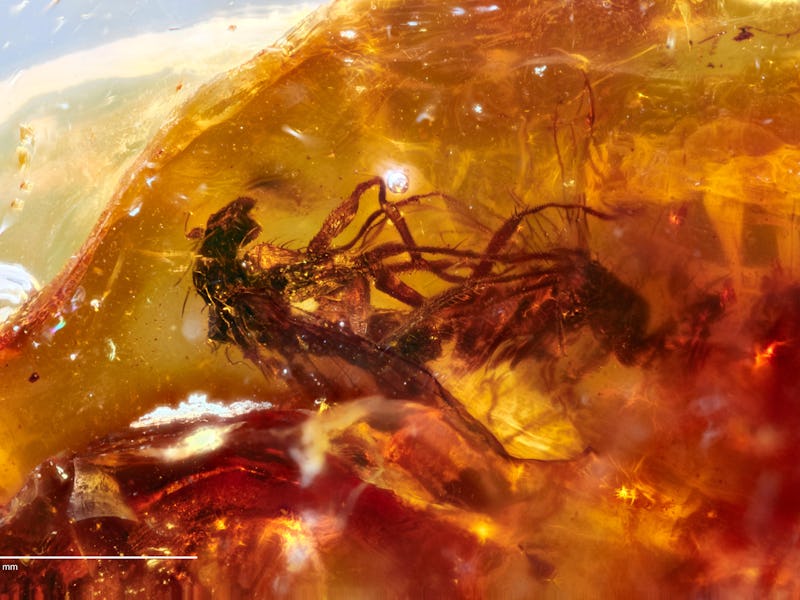Oldest-known example of animal behavior is frozen in time and freaky
Fornicating flies mark the oldest-known "frozen behavior" preserved in amber.

Digging up preserved specimens of Earth’s earliest life gives us a portal to the past — and now, that portal is offering us a voyeuristic peek at the oldest example of animal behavior we yet know of: Mating.
Fly specimens getting busy, beautifully preserved in amber, take us back to what baby-making was like at a time before the planet even had seven distinct continents.
Researchers unearthed the remains of long-legged flies mating, as well as other samples of fossilized ants, wingless hexapods called “slender springtails,” spiders, and biting midges.
They also discovered a few plant samples: namely, liverwort and moss.
A large piece of amber with an association of two flies (long-legged on left and biting midge on right) with the first ever Australian fossil of a large mite of the extant genus, Leptus, Anglesea, Victoria, ca. 41 million years old.
The samples may be as ancient as 230 million years old, according to the study.
The findings are published Thursday in the journal Scientific Reports.
Creatures of the past — The new fossils give us a better understanding of what life was like millions of years ago. Preserved in amber, the fossil flora and fauna are a unique window on the past.
Descendants of the fornicating flies, which themselves date back just 41 million years, are still around now. Today, the same flies eat springtails, aphids, and larvae. They live in habitats near water, in meadows, and at the edges of the woods — though some species stay close to water banks and bodies.
“Significantly, the mating flies represent an extremely rare example of frozen behavior in the Australian fossil record,” the researchers say in the study.
Flies mate for only a few seconds, so the fact that this pair of breeders were caught in the act — and preserved for tens of millions of years — is beyond fascinating.
How did they get stuck in such an intimate moment? The researchers suspect the two flies may have landed on tree resin — the substance that eventually turns into amber — to mate, only to become stuck, and, over the course of millennia, frozen in time.
Flake of clear yellow amber from Anglesea, Victoria containing a new, beautifully preserved biting midge ca. 41 million years old.
Jokes among researchers about the discovery have been, well, flying, lead author Jeffrey Stilwell told Daily Mail.
“You can imagine all of the statements by my amber student volunteers, one being ‘Doin' it Gondwana style,” said Stilwell, a paleontologist at Melbourne’s Monash University.
Capturing this tiny moment in time is “very rare,” Stilwell said.
He called the new findings “one of the greatest discoveries in palaeontology for Australia.”
The fly finding came about while Stilwell and his research team were poring over 5,800 samples of amber.
He and his colleagues believe it may be the earliest example of “frozen behavior” among animals ever discovered.
Gondwana style — In the background of the tale of the fornicating flies is another curious story about the land formations we know today.
Before there were seven continents, there was Pangea. Eventually, the landmass comprising all of above-sea-level Earth split in two, into Laurasia in the north, and Gondwana in the south.
The northern parts of the Earth have so far provided most of our knowledge about the Mesozoic and Cenozoic Eras, thanks to fossils found in amber like these. So chancing upon similar discoveries in what was the southern portion of ancient Earth is exciting for researchers.
In the new research, they scientists report findings spanning the Triassic, Cretaceous, and Paleogene periods. All of the fossils were discovered in Australia and eastern New Zealand.
Finding amber-preserved animals and plants in these parts of the world gives researchers a “first glimpse” at what life was like in the southern part of the ancient Earth. Most recently, paleontologists announced the discover of a minuscule, nightmarish hummingbird, frozen in amber.
As Stilwell told Daily Mail, the discoveries in this region of the Earth are “a dream come true.”
Abstract: The Northern Hemisphere dominates our knowledge of Mesozoic and Cenozoic fossilized tree resin (amber) with few findings from the high southern paleolatitudes of Southern Pangea and Southern Gondwana. Here we report new Pangean and Gondwana amber occurrences dating from ~230 to 40 Ma from Australia (Late Triassic and Paleogene of Tasmania; Late Cretaceous Gippsland Basin in Victoria; Paleocene and late middle Eocene o fVictoria) and New Zealand (Late Cretaceous Chatham Islands). The Paleogene, richly fossiliferous deposits contain significant and diverse inclusions of arthropods, plants and fungi.These austral discoveries open six new windows to different but crucial intervals of the Mesozoic and early Cenozoic, providing the earliest occurrence(s) of some taxa in the modern fauna and flora giving new insights into the ecology and evolution of polar and subpolar terrestrial ecosystems.